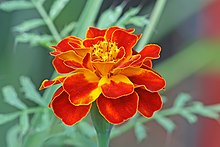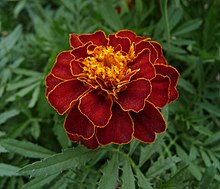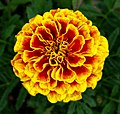| French marigold | |
|---|---|

| |
| Scientific classification | |
| Kingdom: | Plantae |
| Clade: | Tracheophytes |
| Clade: | Angiosperms |
| Clade: | Eudicots |
| Clade: | Asterids |
| Order: | Asterales |
| Family: | Asteraceae |
| Genus: | Tagetes |
| Species: | T. patula |
| Binomial name | |
| Tagetes patula L. | |
| Synonyms | |

Tagetes patula, the French marigold, is a species of flowering plant in the family Asteraceae, native to Mexico and Guatemala with several naturalised populations in many other countries. It is widely cultivated as an easily grown bedding plant with hundreds of cultivars, which often have bright yellow to orange flowers.
Some authorities regard Tagetes patula as a synonym of Tagetes erecta, the Mexican marigold.
Description
Tagetes patula is an annual, occasionally reaching 0.5 m (1+1⁄2 ft) tall by 0.3 m (1 ft) wide. In some climates it flowers from July to October. In its native habitat of the highlands of central Mexico, blooms are produced from September to killing frost. Achenes ripen and are shed within two weeks of the start of bloom. The heads contain mostly hermaphrodite (having both male and female organs) florets and are pollinated primarily by beetles in the wild, as well as by tachinid flies and other insects. The leaves of all species of marigold include oil glands. The oils are pungent. It can grow in both sandy and clay soils provided they have good drainage. It requires full sun to partial shade.

Etymology
The Latin specific epithet patula means 'with a spreading habit'.
Distribution and habitat
The species is native to Mexico and Guatemala with several naturalised populations in many other countries.
Cultivation
This plant is valued for its velvet-textured, brightly coloured blooms in shades of yellow, orange and russet in summer. It is shorter, and has a more spreading habit, than its relative the Mexican marigold (Tagetes erecta). It is therefore more suitable as an edging plant in the open border.
Moreau et al 2006 attempted to protect Solanum tuberosum (potato) against Leptinotarsa decemlineata (potato beetle) by intercropping with T. patula but instead found it acting as an attractant, resulting in greater infestation and lower yields. (They also found the same for another purported repellent, Armoracia rusticana.)
Tagetes patula is frost intolerant, given a Royal Horticultural Society hardiness rating of H2, capable of surviving temperatures of 1–5 °C (34–41 °F) but killed by freezing temperatures. They are grown by gardeners in moderately fertile, but well-drained soil in full sun with evenly moist conditions.
Cultivars
Hundreds of cultivars have been developed, of which the following have gained the Royal Horticultural Society's Award of Garden Merit:-
- 'Bonanza Flame'
- Bonanza Series
- 'Dainty Marietta'
- 'Disco Orange'
- 'Disco Yellow'
- 'Fireball'
- 'Hero Orange'
- 'Honeycomb'
- 'Queen Sophia'
- 'Safari Mixture'
- 'Safari Scarlet'
- 'Safari Tangerine'
- 'Tiger Eyes'
- 'Yellow Jacket'
- 'Zenith Golden Yellow'
- 'Zenith Lemon Yellow'
- 'Zenith Yellow'
Uses
Culinary
The dried and ground flower petals constitute a popular spice in the Republic of Georgia in the Caucasus, where they are known as imeruli shaphrani (= 'Imeretian Saffron') from their pungency and golden colour and particular popularity in the Western province of Imereti. The spice imparts a unique, rather earthy flavour to Georgian cuisine, in which it is considered especially compatible with the flavours of cinnamon and cloves. It is also an essential ingredient in the spice mixture khmeli suneli (reputedly as significant to Georgian cuisine as garam masala is to that of North India).
Colouring
Tagetes patula florets are grown and harvested annually to add to poultry feed to help give the yolks a golden color. The florets can also be used to color human foods. A golden yellow dye is used to color animal-based textiles (wool, silk) without a mordant, but a mordant is needed for cotton and synthetic textiles.
Fragrance
The whole plant is harvested when in flower and distilled for its essential oil. The oil is used in perfumery. It is blended with sandalwood oil to produce 'attar genda' perfume. About 35 kg (77 lb) of oil can be extracted from 1 hectare (2.5 acres) of the plant yielding 2,500 kg (5,500 lb) of flowers and 25,000 kg (55,000 lb) of herbage.
Other
Many cultures use medicinal infusions from dried leaves or florets. Research also suggests that the essential oil has the ability to be used as residual pesticide against bedbugs.
The essential oil is being investigated for antifungal activity, including treatment of candidiasis and treating fungal infections in plants.
Gallery
-
 French Marigold—October Birthday Flower—Tagetes patula
French Marigold—October Birthday Flower—Tagetes patula
-
 Marigold flower
Marigold flower
-
 Moth on flower
Moth on flower
-
 Bunch of flowers
Bunch of flowers
-
 On a plant pot
On a plant pot
-
 Emerging flower
Emerging flower
-
 Sprouting germ
Sprouting germ
-
 Sprouting shoots
Sprouting shoots
-
 Flowerbed
Flowerbed
References
- "Tagetes patula". Germplasm Resources Information Network. Agricultural Research Service, United States Department of Agriculture. Retrieved 2007-09-04.
- USDA Natural Resources Conservation Service. "PLANTS Database". Retrieved 2007-09-04.
- NRCS. "Tagetes patula". PLANTS Database. United States Department of Agriculture (USDA). Retrieved 7 December 2015.
- BSBI List 2007 (xls). Botanical Society of Britain and Ireland. Archived from the original (xls) on 2015-06-26. Retrieved 2014-10-17.
- "Tagetes patula". The Plant List. Retrieved 1 December 2018.
- ^ Soule, J. A. 1993. "The Biosystematics of Tagetes" Ph.D. Dissertation, University of Texas
- "Tagetes patula (French Marigold) | North Carolina Extension Gardener Plant Toolbox". plants.ces.ncsu.edu. Retrieved 2022-03-18.
- Harrison, Lorraine (2012). RHS Latin for Gardeners. United Kingdom: Mitchell Beazley. ISBN 978-1845337315.
- Rydberg, Per Axel 1913. in Britton, Nathaniel Lord, North American Flora 34: 154-155
- Brickell, Christopher, ed. (2008). The Royal Horticultural Society A-Z Encyclopedia of Garden Plants. United Kingdom: Dorling Kindersley. p. 1021. ISBN 9781405332965.
- Parolin, Pia; Bresch, Cécile; Desneux, Nicolas; Brun, Richard; Bout, Alexandre; Boll, Roger; Poncet, Christine (2012). "Secondary plants used in biological control: A review". International Journal of Pest Management. 58 (2). Taylor & Francis: 91–100. doi:10.1080/09670874.2012.659229. ISSN 0967-0874. S2CID 85314072.
- Webster, Ben; Cardé, Ring T. (2016-05-04). "Use of habitat odour by host-seeking insects" (PDF). Biological Reviews of the Cambridge Philosophical Society. 92 (2). Cambridge Philosophical Society (Wiley): 1241–1249. doi:10.1111/brv.12281. ISSN 1464-7931. PMID 27145528. S2CID 207102508.
- "Tagetes patula - French marigold". RHS Gardening. Royal Horticultural Society. Retrieved 25 April 2023.
- MBG. "Tagetes patula". Missouri Botanical Garden Plant Finder. St. Louis, MO: Missouri Botanical Garden. Retrieved 25 April 2023.
- "AGM Plants - Ornamental" (PDF). Royal Horticultural Society. July 2017. p. 100. Retrieved 1 December 2018.
- "Tagetes patula 'Bonanza Flame' (Bonanza Series)". RHS. Retrieved 5 March 2021.
- "Tagetes patula Bonanza Series". RHS. Retrieved 5 March 2021.
- "RHS Plantfinder - Tagetes patula 'Dainty Marietta'". Retrieved 1 December 2018.
- "RHS Plantfinder - Tagetes patula 'Disco Orange'". Retrieved 1 December 2018.
- "RHS Plantfinder - Tagetes patula 'Disco Yellow'". Retrieved 1 December 2018.
- "Tagetes patula 'Fireball'". RHS. Retrieved 5 March 2021.
- "RHS Plantfinder - Tagetes patula 'Hero Orange'". Retrieved 1 December 2018.
- "RHS Plantfinder - Tagetes patula 'Honeycomb'". Retrieved 1 December 2018.
- "RHS Plantfinder - Tagetes patula 'Queen Sophia'". Retrieved 1 December 2018.
- "RHS Plantfinder - Tagetes patula 'Safari Mixture'". Retrieved 1 December 2018.
- "RHS Plantfinder - Tagetes patula 'Safari Scarlet'". Retrieved 1 December 2018.
- "RHS Plantfinder - Tagetes patula 'Safari Tangerine'". Retrieved 1 December 2018.
- "RHS Plantfinder - Tagetes patula 'Tiger Eyes'". Retrieved 1 December 2018.
- "RHS Plantfinder - Tagetes patula 'Yellow Jacket'". Retrieved 1 December 2018.
- "Tagetes 'Zenith Golden Yellow' (Zenith Series)". RHS. Retrieved 5 March 2021.
- "Tagetes 'Zenith Lemon Yellow' (Zenith Series)". RHS. Retrieved 5 March 2021.
- "Tagetes patula 'Zenith Yellow' (Zenith Series)". RHS. Retrieved 5 March 2021.
- Goldstein D. 1993 "The Georgian Feast" HarperCollins
- Politi, Flávio Augusto Sanches; Nascimento, Juliana Damieli; Da Silva, Alexander Alves; Moro, Isabela Jacob; Garcia, Mariana Lopes; Guido, Rafael Victório Carvalho; Pietro, Rosemeire Cristina Linhari Rodrigue; Godinho, Antônio Francisco; Furlan, Maysa (2016). "Insecticidal activity of an essential oil of Tagetes patula L. (Asteraceae) on common bed bug Cimex lectularius L. And molecular docking of major compounds at the catalytic site of ClAChE1". Parasitology Research. 116 (1): 415–424. doi:10.1007/s00436-016-5305-x. hdl:11449/173767. PMID 27838836. S2CID 24672255.
- B. K. Dutta; S. Karmakar; A. Naglot; J. C. Aich & M. Begam (March 2007). "Anticandidial activity of some essential oils of a mega biodiversity hotspot in India". Mycoses. 50 (2): 121–124. doi:10.1111/j.1439-0507.2006.01332.x. PMID 17305775. S2CID 19565277.
- Mares D, Tosi B, Poli F, Andreotti E, Romagnoli C (2004). "Antifungal activity of Tagetes patula extracts on some phytopathogenic fungi: ultrastructural evidence on Pythium ultimum". Microbiol. Res. 159 (3): 295–304. doi:10.1016/j.micres.2004.06.001. hdl:11380/310598. PMID 15462529.
- C. Romagnoli; R. Bruni; E. Andreotti; M. K. Rai; C. B. Vicentini & D. Mares (April 2005). "Chemical characterization and antifungal activity of essential oil of capitula from wild Indian Tagetes patula L". Protoplasma. 225 (1–2): 57–65. doi:10.1007/s00709-005-0084-8. PMID 15868213. S2CID 34734081.
| Taxon identifiers | |
|---|---|
| Tagetes patula |
|